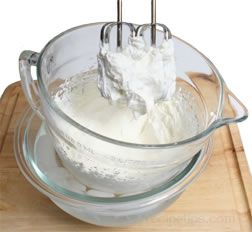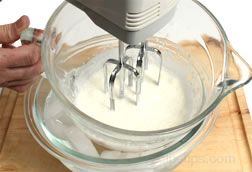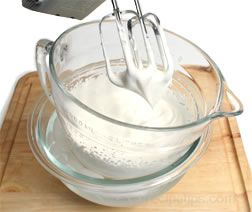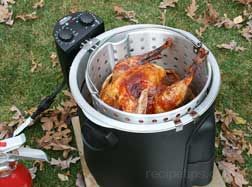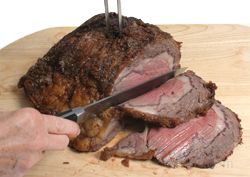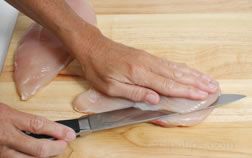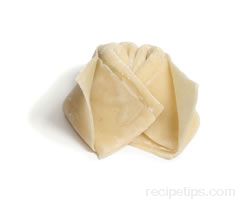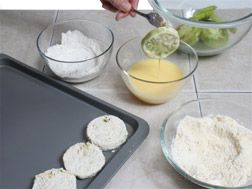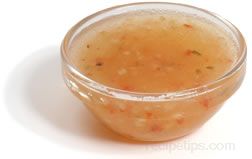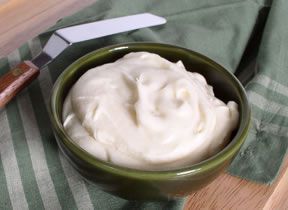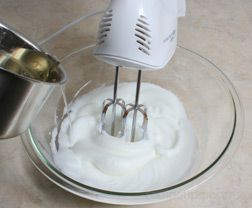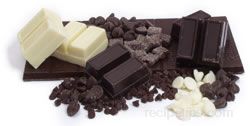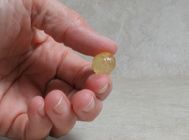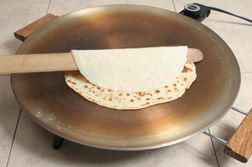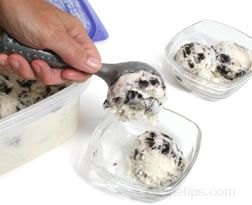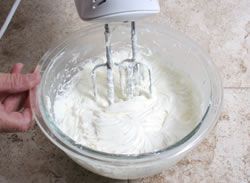|
Types of Cream | Flavoring Whipped Cream | Preparing in Hot or Cold Weather
Whipping the Cream | Stabilizing Whipped Cream | Storing | Other Whipped Toppings
Whipping cream can be used for several purposes. A common use is for making a whipped topping for cakes, pies and other desserts. It is also used as an ingredient in recipes for desserts, soups, sauces and beverages. To make whipped toppings, heavy cream is whipped, using a whisk, hand-mixer or stand mixer. The mixing process creates air bubbles in the cream and as the cream is whipped the fat is distributed among the air bubbles, which causes them to stick together and create foam. The fat particles must be cold for them to stick together.
Types of Cream
The amount of butterfat contained in the cream will determine how well cream will whip and how stable it will be. See the chart below for some of the different types of cream you will find available.
| Types of Cream |
| Type |
Butterfat Content |
Uses |
| Half and Half Cream |
10 1/2 to 12% |
Not used for whipping. Generally used in beverages. |
| Single Cream |
20% |
Not used for whipping. Used in both sweet and savory dishes. |
| Light Cream |
18 to 30% |
Will whip if it contains 30% butterfat but will not be very stable. Generally contains only 20% butterfat. |
| Whipping Cream |
30% |
Does not whip as well as heavy cream but works well for toppings and fillings. |
Heavy Cream or
Heavy Whipping Cream |
36 to 40% |
Whips up well and holds its shape. Doubles in volume when whipped. |
| Double Cream |
48% |
Whips up very quickly and is easy to overwhip. Also used in custard, pies and sauces. |
| Clotted Cream |
55 to 60% |
Does not need whipping, use as is. Found in specialty food stores. |
| Pasteurized and Ultra-pasteurized: Creams will generally be labeled pasteurized or ultra-pasteurized. Ultra-pasteurized creams will remain fresh longer but pasteurized will provide a better flavor, will whip up fluffier, and will hold up longer. If pasteurized cannot be found, ultra-pasteurized will work. |
Flavoring Whipped Cream
Whipped cream is generally sweetened with sugar and can also have flavoring added to it for special recipes. The whipped cream can be sweetened with granulated sugar, superfine sugar or powdered sugar. They will all work for sweetening the cream but superfine and powdered sugar will dissolve quicker and prevent the whipped cream from being gritty. Powdered sugar will also help stabilize the whipped cream because it generally contains cornstarch. Add 1 to 2 tablespoons of granulated, superfine or powdered sugar per 1 cup of cream.
There are many flavorings that can be added to whipping cream to create a unique taste. Some of the flavorings used are extracts, spices, citrus zest, coffee, liqueur, and chocolate. The chart below shows some flavorings that are used for whipped cream and gives a suggested amount to use.
| Types of Flavorings |
| Type |
Amount (per cup of cream) |
| Almond Extract |
1/4 teaspoon |
| Vanilla Extract |
1/2 to 1 teaspoon |
| Flavored Liqueur |
1 teaspoon |
| Brandy or Rum |
1 teaspoon |
| Citrus Zest |
1 to 2 teaspoons |
| Coffee |
1 to 2 teaspoons of instant coffee plus 1 teaspoon of vanilla extract |
| Chocolate |
2 tablespoons of sifted cocoa plus 1 teaspoon of vanilla extract |
| Cinnamon |
Sprinkle on top of whipped cream when
ready to serve. |
| Note: Also add 1 to 2 tablespoons of sugar per cup of cream when adding the flavorings as shown above. |
When to Add the Sugar and Flavoring:
- The sugar and flavoring should be added just as the cream starts to form a soft peak.
- Add the sugar and flavoring slowly along the side of the mixing bowl.
- Continue to whip as the sugar and flavoring are added.
- Whip cream until it has doubled in volume and forms a stiff peak.
If the sugar or flavoring is added before the cream has started to be whip, it will not whip up to its full volume. Also be careful that the cream does not get overwhipped. If the cream is overwhipped it will begin to separate and curdle, and then turn to butter.
Preparing Whipped Cream in Hot or Cold Weather
Whether it is during hot or cold weather the same basic method is used for whipping cream. The important thing to keep in mind is that the working environment should be as cool as possible and the ingredients and the utensils used should be well chilled.
Keeping It Cool!
- The cream should be kept in the coldest part of the refrigerator until just before using.
- The beaters and mixing bowl, or the wire whisk should be placed in the freezer for at least 15 minutes before whipping the cream.
- Place the mixing bowl in a larger bowl of ice water to keep the bowl chilled while whipping the cream.
- HOT WEATHER: Whip in an air-conditioned room. If you do not have air conditioning, whip in the coolest part of your house and be sure to have the mixing bowl sitting in a bowl of ice water.
- COLD WEATHER: Slightly open a window in the work area, preferably one where the cool air can blow in directly at the bowl containing the cream.
Whipping the Cream
To make 2 cups of whipped cream: Use 1 cup of heavy cream
Stabilizing Whipped Cream
Stabilizing whipped cream gives it a firmer texture and allows it to be used as piping for a decorative border on a cake, prevents it from weeping, and stops it from deflating when mixed with juicy ingredients, such as strawberries and raspberries. Follow instructions below to stabilize whipped cream.
- Soak 1/2 teaspoon of plain gelatin in 1 tablespoon of cold water for 5 minutes.
- Place the gelatin and cold water in a heat resistant container and set in a small pan of very hot water just until the gelatin is dissolved. If heating on a stove, do not allow the gelatin to boil.
- After gelatin has dissolved, set it aside to cool. Allow it to cool to about body temperature. Note: if the gelatin is too hot it will deflate the whipped cream when it is added and if it is allowed to cool too much it will thicken too much and not incorporate into the cream.
- Follow instructions above for whipping the cream. Add the gelatin after the sugar and flavoring has been whipped in but before the cream forms soft peaks.
- Once the gelatin is incorporated in the whipped cream, beat until cream forms soft peaks, and then stop beating with the electric mixer. Finish whipping with a wire balloon whisk to bring the cream to the desired consistency.
- If the whipped cream is to be spread on a cake or dessert, use immediately because it will set quickly and become difficult to spread.
Using gelatin to stabilize whipping cream can be a problem if not done properly. Some other methods that can be used to help stabilize the whipped cream are shown below:
- Add 2 teaspoons of nonfat dry milk to one cup of cream before whipping.
- Add 1 teaspoon of light corn syrup to one cup of cream before whipping.
- Use powdered sugar instead of granulated sugar when sweetening. Powdered sugar generally contains cornstarch which helps stabilize the whipped cream.
- Incorporate a melted marshmallow into the whipped cream towards the end of whipping.
- Use a commercial type stabilizer that binds the liquid parts of the cream, helping to stabilize it. One of the types available is Dr. Oetker's Whip It.
Storing Whipped Cream
Cream and whipped cream are dairy product and are perishable so they need to be stored in the refrigerator.
Storing Cream:
- Store cream in the coldest part of the refrigerator.
- Store for up to one week after the date on the carton.
- Cream can be frozen for longer storage. Be sure there is sufficient room in the carton for expansion and then wrap it in a freezer-safe bag. Freeze for up to 6 months. Thaw in the refrigerator and shake well before using.
Storing Whipped Cream:
- It is best to prepare whipped cream just before using but if it is necessary to make ahead of time, it can be kept in the refrigerator for up to 48 hours if stored properly. To store, prepare as directed above and then place in a sieve lined with cheesecloth. Place the cheesecloth lined sieve in a bowl that will hold the sieve so it is 2 inches from the bottom. Cover it tightly and refrigerate. If whipped cream is a little stiff when ready to use, whisk in 1 to 2 tablespoons of cream to soften.
- If there is a small amount of whipped cream leftover, place in an airtight container and refrigerate. Best to use within 24 hours. A good way to use leftover whipped cream is to drop a spoonful on top of a cup of coffee or hot chocolate.
- Whipped cream can also be frozen for later use. Line a cookie sheet with plastic wrap and then drop serving size mounds on the plastic. Place in the freezer uncovered. When frozen, remove from the plastic, place in a sealable plastic bag, and place back in the freezer. Remove servings as needed. Can be stored in the freezer for up to 2 weeks.
Other Whipped Creams
Cool Whip: A non-dairy whipped topping that can be substituted in equal amounts for whipped cream. It keeps longer and has fewer calories. It does not need to be whipped. It is ready to use when purchased. It is often frozen when purchase and should be allowed to thaw in the refrigerator. If stirred, it will begin to break down so when used in recipes with other ingredients it should be folded in gently. Foods prepared with cool whip should be stored in the refrigerator.
Whipped Toppings in a Can: A type of whipped topping made up of cream, sugar, stabilizers, emulsifiers, and gas in a pressurized can. When released from the can, the gas expands the cream to create a puffy whipped topping. Must be stored in the refrigerator. |





